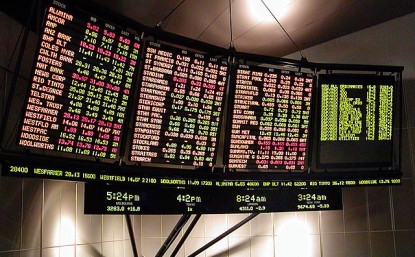
1. Have US stocks entered a bear market?
2. In most assets, MSM (mainstream media) uses a 20% decline as a rule of thumb to define a bear market. While an asset that’s declined 20% might be in a bear market, that rule of thumb is at best a very crude attempt to define the overall price action.
3. Different assets require different rules of thumb. Dow Theory provides a time-tested means of classifying the US stock market as bullish or bearish.
4. On that note, please click here now. That’s the weekly chart of the Dow Jones Transportation index.
5. Next, please click here now. That’s the weekly chart of the Dow Jones Industrials index.
6. In terms of time, a Dow Theory sell signal is quite a long process; both averages must make a series of lower intermediate trend lows and highs. In the case of the current market, that may happen, but it hasn’t happened yet.
7. The professional Dow Theorist is now watching for an intermediate trend rally to occur in both averages. If they fail to breach the recent highs, that in itself is not a sell signal.
8. A sell signal would occur only if both averages then decline and close below yesterday’s closing prices.
9. For decades, I have defined the August 7 – October 31 time frame as “crash season”. There’s no question that current US stock market price action is very concerning.
10. The real risk of being invested in US stocks during these three months dramatically outweighs any potential reward. That’s because generational wealth can be destroyed in a few days, weeks, or even hours. August is typically the set-up month, and the crash and/or ensuing bear market occurs in either September or October.
11. Please click here now. That’s a monthly chart of the Dow Industrials. The uptrend from the 2009 lows has been broken, and the key 5,15 moving average series is rolling over, ominously. I’m a buyer of the Dow only at 14,200, which is where massive buy-side horizontal support (HSR) begins.
12. Gold and silver enthusiasts are disappointed that there was not a rush into gold as the Dow tumbled. The SPDR ETF holding did rise modestly, from about 677 tons to 681, but yesterday’s price action was slightly negative.
13. The safe haven trade for gold relates more to key bond markets than to stock markets. In my professional opinion, there are two reasons that Janet Yellen would hike rates. The first is to boost money supply velocity (by boosting bank loan profits).
14. I also think that Janet shares Alan Greenspan’s concerns about the long term economic problems caused by the size of government. Military spending and entitlement programs don’t do much for money supply velocity. In contrast, by raising rates, Janet can direct institutional liquidity flows away from the T-bond market, away from government, and into the private sector.
15. Rate hikes can reverse declining money supply velocity, and potentially quite violently. That’s good news for gold and silver bugs! Obviously, I’m 100% in favour of a September rate hike. Regardless of when it occurs, global stock and bond markets could stage a horrific meltdown after the first rate hike, while gold and silver rally strongly!
16. Fortunately or unfortunately, depending on your perspective, most of the price action in the gold market is not directly related to economic events in the West. It’s mainly related to demand for gold jewellery versus mine and scrap supply in India. The key point is that when Indian demand is very strong, gold-bullish events in the West can cause enormous surges in the price.
17. Likewise, when Indian demand is tepid, events in the West that “should be bullish” don’t have much effect on the price, and that can frustrate gold enthusiasts. Ominously, when Indian demand is weak (typically from February to July/August), events in the West that are bearish for gold can cause substantial declines in the price.
18. The good news right now is that Indian jewellers, refiners, and economists are forecasting very strong demand over the next four months! That means any event in the West that is even modestly bullish for gold could send the price much higher.
19. Please click here now. Indian Dore bar imports are surging, with refiners predicting 50% growth this year. The lower duty is a key factor, and I expect this to continue for many years.
20. China is also a key source of demand for gold. Please click here now. That’s one take on China, from a key Goldman Sachs analyst. I’ll add that Hong Kong’s stock market sports an average P/E ratio of about 8. The PBOC has plenty of room to cut rates substantially, and the country has almost $4 trillion in FOREX reserves.
21. The Chinese stock market is suffering a hard landing, but I don’t see the Chinese economy suffering the same fate. Even if there is a hard landing, China doesn’t need to grow dramatically to boost gold demand consistently. Modest growth is fine, and that’s in play now.
22. Another overlooked area of gold demand is Iran. I’ve predicted that Iran will become an economic “powerhouse”, while Saudi Arabia declines. Pleaseclick here now. Iran bought a staggering 200 times more gold jewellery from Turkey this year than last year. Switzerland has also started re-exporting gold to Iran. Once all the Western sanctions are gone, I’m projecting that Iranian gold jewellery demand will reach 300 – 400 tons a year very quickly, making it the third most important gold market in the world!
23. Please click here now. That’s the daily gold chart. After what is roughly a $100 rally, investors need to be patient, and prepare for a pullback. Pleaseclick here now. That’s another look at the same chart. There may be a second flag pattern forming, which is very bullish. A pullback to $1125 is more likely, but overall the chart looks solid.
24. Please click here now. That’s the GDXJ weekly chart. There’s a great looking bull wedge pattern in play, with an intermediate term target of $45. I realize that junior gold and silver stock enthusiasts are in a bit of pain after yesterday’s general market meltdown, and there could be more if gold declines to the $1125 area. Investors don’t need to “grin and bear it”. They need to grin and buy it! The strong season for gold is off to a typical start, with gold quite strong, and the stocks very volatile. The junior gold stocks will take the lead baton soon, and start the rise to $45 on the GDXJ chart!
Stewart Thomson of Graceland Updates, Guest Contributor to MiningFeeds.com

[Note: over the past month the S&P500 is down 5.23%, the DJIA down 6.31% and Gold (KITCO Charts) UP 5.23%] (stock futures are down 4% Monday morning)
The following interview of Shawn Wallace, President and CEO of Auryn Resources Inc.was conducted by Peter Epstein, CFA, MBA in the week ending August 21st. From the Company’s website, quote, “Auryn Resources is a junior mining exploration company focused on delivering shareholder value through project acquisition and development. The Company’s management team is highly experienced with an impressive track record of success in the exploration, discovery, development and financing of mining assets.” This is true. However, upon reading this interview, readers should learn that there’s a lot going on at Auryn.
Following the recent sale of Cayden Resources, several key members moved to the next big thing, Nunavut Territory in Canada. There’s a lot of activity in Nunavut, [please refer to page 8] of the Company’s corporate presentation. The next paragraph recaps page 8, but there’s a map on that page delineating additional exploration, development and production in Nunavut.
Agnico’s Meadowbank 2015, an estimated 400,000 ounces of gold at $656/oz cash cost. Agnico’s Amaruq $20 million in 2015 exploration work with 50,000 m of drilling and an inferred resource of 1.5 million ounces @ 7 g/t Au. Agnico’s Meliadine P & P resource of 3.3 million ounces @ 7.44 g/t Au, plus a measured & indicated resource of 3.3 million ounces @ 5 g/t Au and an inferred resource of 3.5 million ounces @ 7.6 g/t Au. TMAC Resources’ Hope Bay completed a $135 million IPO for a total of $182 million raised since 2013, TMAC has a measured & indicated resource of 4.4 million ounces @ 9.6 g/t Au. Sabina Gold & Silver’s Black River has a measured & indicated resource of 5.2 million ounces @ 5.81 g/t Au and a recently released a positive feasibility study.
Mr. Wallace, thank you again for taking the time to answer my questions. Please describe Auryn Resources and its key project.
Auryn Resources Inc. (TSX-V:AUG) (OTCQX: GGTCF) is a well-financed and technically driven gold exploration company boasting an experienced management, Board and technical team with a proven track record of success. Auryn is currently advancing the Committee Bay Gold Project “CBGP.” The mineral project, located in Nunavut Territory, Canada, includes 66,160 hectares (163,485 acres) situated along the Committee Bay Greenstone Belt, “CBGB.”
What attracted us most to CBGP are its high-grade gold endowment, existing exploration infrastructure, mining friendly jurisdiction, major mine developments in the region and district scale discovery opportunities. Our property extends more than 300 kms northeast to the shores of Committee Bay, and is roughly 180 kms NE of Agnico Eagle’s “Agnico” Meadowbank mine. Importantly, we are in the process of acquiring North Country Gold Corp. (TSX-V:NCG), holder of a 49% stake in the CBGP project. This acquisition would consolidate 100% of the property for Auryn.
The project benefits from existing infrastructure including, “Bulk storage fuel facilities, 5 high efficiency drill rigs, a heated drill water system, heavy equipment on site, a 100 person camp at our main Three Bluffs deposit area and two satellite camps SW of the belt.”
See corporate presentation. The CBGB comprises one of a number of attributes that are thought to be equivalent to that of other significant gold bearing deposits such as Agnico’s Meadowbank and Meliadine mines. High-grade gold occurrences are found throughout the 300 kms strike length, including the Three Bluffs deposit that contains a NI 43-101 compliant Indicated & Inferred resource of 1.2 million ounces of gold. The Three Bluffs deposit remains open for expansion both along strike and at depth, giving us tremendous exploration upside.
Much has been written about previous successes. What have you learned that might carry over to Auryn?
Junior exploration company Auryn Resources, (TSX-V:AUG) (OTCQX: GGTCF) is the third company that Auryn Chairman Ivan Bebek and I have started. We also founded Keegan Resources and later Cayden Resources. Keegan became Asanko Gold and merged with its neighbor, PMI Gold. While working with Asanko in Ghana, we met Auryn’s COO Michael Henrichsen, a brilliant structural geologist who was at Newmont. Long before Cayden was acquired by Agnico, our team had already began a global search for our next gold play.
We reviewed close to 200 prospects. We searched in several countries and looked at assets at varying stages of exploration and development. We screened each by three essential criteria; it had to be a district-scale opportunity, i.e. a land package where multiple deposits could be discovered and developed; it had to be in a stable jurisdiction; and it had to be high-grade. It’s only in times like these when one can acquire high-grade assets at attractive valuations.
We are a group of experts in mineral exploration, that’s what we do.
We are not in the business of building mines. We’re a lean team, comprised of highly experienced executives and geoscientists blessed with a wide range of critical capabilities. Many in our group have participated in every capital raise we’ve done and myself and Chairman Bebek recently acquired shares in the open market.
We made investors in Keegan Resources and Cayden Resources a fair amount of money, funds that our loyal shareholders are entrusting with us again. Committee Bay in Nunavut ticked off all the boxes. The Committee Bay asset represents the highest grade, most potentially scalable, with the largest number of NI 43-101 compliant resource present, compared to our previous companies. If we close the proposed acquisition of North Country Gold as expected, we are off to the races!
Auryn’s stated goal is to discover a major high-grade gold district, what gives you confidence in achieving that goal?
Our main focus at the moment is to try to find and explore an abundance of recently identified, existing and additional targets. We believe that we might be able to expand Three Bluffs but we would not be starting work on it until 2016 at the earliest. We really don’t know for sure how many ounces of gold we might discover, however we could not have rationalized the JV or the proposed takeover of NCG had we not believed the potential for much more gold.
Approximately $100 million has been spent on Committee Bay, the vast majority before Auryn entered the picture. Explain the work done and the value of it.
$100 million in expenditures have led to the following benefits: Exploration infrastructure in place with camps, runways, etc… allowing us to effectively execute and stage our exploration plans. Delineation of the 1.2 million Indicated & Inferred gold ounces @ +8g/t at Three Bluffs, a number we hope will grow in size and grade. Potential identification of high-grade prospects at Inuk, Raven, West Plains, & 4 Hillsas deposit footprints that could be explored, and if warranted, expanded to move them toward a prospective resource. Abundant geophysical data in the form of airborne EM surveys over the high-grade prospects. Belt-wide prospecting and identification of high-grade gold occurrences with no follow up drilling.
Is Auryn encumbered by any debt, streaming or royalty funding?
No, another hallmark of our prudent approach is that we try to avoid using debt and debt like funding vehicles such as streaming and royalty transactions. It’s too early for Auryn to even consider these options and frankly we would not be inclined to adopt any of the avenues you mentioned except as a last resort.
Few things can kill a promising project, lack of funds to advance, failure to find enough gold and onerous debt covenants. We avoid debt and aspire to minimize the amount of equity capital raised. That’s why we have such a solid capital structure and devoted shareholders. Even after possibly consolidating Committee Bay, our capital structure would remain in great shape.
Speaking of capital structures, can you give us the latest version of yours?
Our capital structure is very straightforward. We have 30 million shares outstanding and 32 million fully diluted, no debt, no preferred shares, and as mentioned, no streaming or royalty mechanisms in place. Pro forma for the merger and $4.8 million capital raise, our capital structure would contain about 47 million fully diluted shares. If exercised, proceeds would add $2.5 million to our coffers).
With no change in our debt, streaming or royalty situation. We remain confident that our shareholders, management and Board will continue to support the company as needed. I hesitate to say this, but our stakeholders constantly tell me and Chairman Bebek that high risk capital follows the winners. We are lucky to have two successes under our belts. Clear evidence of management’s conviction in Auryn is Chairman Bebek’s $500,000 of open market share purchases this year.
Are there analog exploration, development and producing mine(s) to point to?
People readily compare our deposit with Agnico’s Meadowbank mine, 150 kms SW of CB. Agnico’s primary exploration focus, Amaruq is also 150 kms SW of CB Meadowbank was Agnico’s largest gold producer in 2014. According to Agnico’s website, that mine is expected to produce 400,000 ounces in 2015. The character and history of rock packages, and the timing and nature of mineralization occurring within the CBGB is considered to be geologically similar to that of other significant gold bearing greenstones hosting mines such as Meadowbank and Meliadine. We see no evidence or red flags suggesting that our prospective deposits couldn’t be as large as Meadowbank’s. However, the truth is that no one knows what we might, (or might not), have on our expansive property.
Where does Auryn stand regarding additional acquisitions, or is North Country Gold enough for now?
The Company is continuing to actively pursue other high quality mineral opportunities with the goal of establishing a robust project pipeline. Active discussions and ongoing due diligence with a number of parties in North and South America continues with the goal of establishing exploration and development operations in those regions.
In addition to Three Bluffs, your corporate presentation details a, “pipeline of drill ready,” “tier 2″ deposits in Inuk, Raven, West Plains, & 4 Hills. How might they fit into Auryn’s plans?
The targets are effectively potential deposit footprints that have been identified by our predecessors (North Country Gold) with very limited drilling. Our focus is to bring geologic context to these footprints and explore and possibly expand them to determine if we can move them toward a potential resource.
What are some key near and intermediate term activities to watch for?
Good question. Near-term we will complete a comprehensive framework study across the 300 kms Committee Bay Belt, incorporating the $100 million of historic exploration expenditures detailed above. We would also like to conduct ground IP and surface programs across West Plains, Raven and other newly defined targets and design our 2016 work program based off of 2015 exploration results.
In the intermediate time frame, our historical database has highlighted 115 rock samples grading above 5g/t gold that have not had any follow up or first pass drilling within a 200 meter radius. We believe that a large campaign of low-cost drilling could lead to the discovery of new deposit footprints. Our goal is to drill 1,000 + RAB holes into the Committee Bay Belt in 2016 & 2017 alone. Remember, we will be exploring a 4 km gold trend open along strike and at depth. There’s no shortage of exploring to be done on even that small fraction of our land holdings.
Thank you again Mr. Wallace, President and CEO of Auryn Resources Inc., for your time and consideration.
Video Interview of Wallace by Jay Taylor
Contact Info: Peter Epstein, epstein.peter4@gmail.com US: 845-304-7386 http://EpsteinResearch.com
Disclosures: Auryn Resources (TSX-V:AUG) (OTCQX: GGTCF) is a small cap stock that’s speculative, not suitable for all investors. I, Peter Epstein, own shares of UURAF. Mr. Epstein, CFA, MBA is not a licensed financial advisor. Readers should take that fact into consideration. Readers are encouraged to consult with their own investment advisors before buying or selling any stock, especially speculative ones like Auryn. I conduct a lot of written interviews and articles that are popular among readers. At the time that this interview was posted, Auryn Resources was a sponsor of: http://EpsteinResearch.com. Please consider visiting: http://EpsteinResearch.com for free updates on Auryn Resources and other companies. Thank you for supporting my articles / interviews by visiting my website.
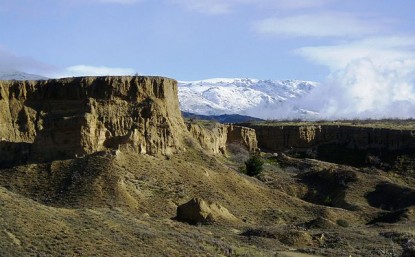
The smaller gold miners and explorers have suffered catastrophic stock-price losses in recent years. These extreme declines have led investors and speculators to assume that much of this sector won’t survive lower prevailing gold prices. But nothing could be farther from the truth. The hated and left-for-dead junior-gold sector is not only very strong financially today, but could still thrive at much lower gold prices.
With many hundreds of junior gold stocks trading around the world, this sector isn’t easy to measure. They range from smaller producers with fantastic operating mines, to explorers doggedly advancing their projects in these dark times, to countless garbage shell companies that will never do anything beyond fleecing the unwary. The proliferation of junior golds is incredible, making it difficult to wade through the morass.
For many years contrarian analysts including me struggled with attempts to track the performance of junior golds as a sector. Many proprietary indexes were constructed, but they never caught on. Finally in November 2009, a major ETF player solved this problem. That’s when Van Eck Global launched the Junior Gold Miners ETF, which trades as GDXJ. It has become the metric of choice for measuring this sector.
And per GDXJ, the carnage in junior golds has been astounding. It peaked back in April 2011 way up near $152 on a split-adjusted basis. But soon gold crested so traders started fleeing its miners and explorers. GDXJ’s bottom fell out. Things got so bad that GDXJ’s custodians felt compelled to execute a 1-for-4 reverse split in July 2013. But with gold remaining weak since, the heavy junior-gold selling continued.
By earlier this month after that extreme gold shorting attack spawned a gold-stock panic, GDXJ plunged to an all-time split-adjusted low around $18. Its total loss over 4.3 years was a devastating 87.8%! There is little doubt junior golds were the worst-performing sector in all the stock markets, a terrible distinction. Such mind-boggling wealth destruction led most investors and speculators to exit this cursed sector forever.
Like everyone who sells low after a long price decline, these traders attempted to rationalize their fleeing decision as prudent and wise. There was a growing consensus that most of the smaller gold miners and explorers were doomed. Gold prices were too low to fuel profitable operations for the miners, and the explorers didn’t have a prayer of raising essential capital in these equity markets. The juniors had no hope.
But as always when literally everyone is convinced any sector will move in one direction forever, this sentiment was dead wrong. While it’s been an exceedingly-challenging couple of years for the junior gold companies, they’ve ridden out this hellstorm surprisingly well. You certainly wouldn’t know it from their epically-low stock prices, but their operational performance and financials today are actually quite strong!
This heretical idea is so counter to popular opinion that few are even willing to consider it. Anyone that is foolish enough to even assert that junior golds have strong financials today will be laughed off of the podium. But that’s exactly what the cold, hard data from the junior golds’ brand-new Q2 financial results proves. And the definitive list of elite junior gold stocks is found in the holdings of that GDXJ junior-gold ETF.
This week GDXJ’s custodians held 61 “gold stocks” in this ETF’s portfolio. The quotation marks are because this “Junior Gold Miners ETF” oddly includes silver miners as well. It also has exploration-stage companies, royalty companies, and streaming companies, all of which aren’t technically gold miners. But these other types of ventures are certainly within the wheelhouses of junior-gold investors and speculators.
Reading through quarterly reports is tedious and time-consuming, and I didn’t have enough time or patience this week to read through all 61 of GDXJ’s component companies’ results. So I chose the 34 largest GDXJ components, the stocks with the top weightings, to analyze their Q2 results. Why 34? That’s how many fit in these tables below. Together they account for over 5/6ths of the entire weight of GDXJ.
This deep-research project actually started last week, when I did the same for the major gold miners of the GDX Gold Miners ETF. Also strangely, some of GDX’s components are also included in GDXJ. If I was constructing these underlying indexes, I certainly wouldn’t allow overlap. My thesis last week was that the popular notion that the gold-mining industry’s costs today are around $1200 per ounce is totally false.
The bears spent last month using this fallacy to argue that selling gold stocks at extreme lows was totally rational, since these companies couldn’t survive for long under $1200. But the actual Q2 results from the top 34 GDX components proved that this industry’s average all-in sustaining costs were just $895 per ounce. As long as gold is above those far-lower levels, their operations continue to remain profitable.
Equally important, the major gold miners of GDX had an average cash cost in Q2 of just $635 per ounce! That means they could survive for a long time even if gold was to miraculously plunge far under $800 as some of the legions of bears still forecast. After that popular essay showing today’s gold prices and far lower are no threat to gold miners, I got a deluge of e-mails wondering about the juniors’ precarious position.
Theoretically the larger gold miners should be much stronger than the smaller ones. The big guys have multiple mines, with many having multiple orebodies with different cost structures from which to mine gold. Their diversified mine portfolios give them far more flexibility in weathering extreme gold-price anomalies than single-mine operations, which describes most junior miners. They should’ve looked worse.
So I was shocked this week to find that the junior gold miners were actually looking stronger than the majors in some ways! Their collective costs of mining gold are slightly lower than the majors’, in both cash and all-in-sustaining terms. Of the top 34 companies in GDXJ, the gold miners had average cash and all-in sustaining costs of $613 and $858 in the second quarter of 2015! They are actually thriving today.
These tables summarize the results from those 34 top-GDXJ-component quarterly reports. Not all data was provided by every company, as they trade around the world on different exchanges with different financial-reporting standards. Whenever I couldn’t find information for a company, I left that field blank. The explorers are evident as the companies with zero production in Q2, shown in the final column on the right.
Each company’s cash cost per ounce, all-in sustaining cost per ounce, and AISC guidance for all of 2015 is noted. I also looked at balance-sheet strength in terms of cash on hand, cash’s percentage of the current market capitalization, cash provided by operations, and debt service. While the latter couldn’t fit on these tables, none of these companies had any problems easily making debt payments with operating cash flows.
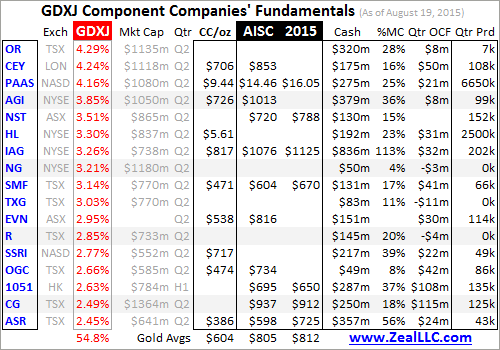
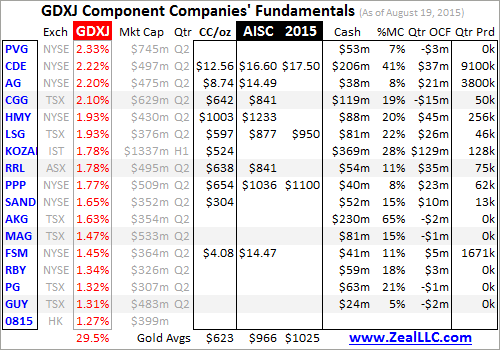
The top junior-gold companies’ Q2 results revealed a vastly-healthier industry than anyone believes with their stocks in the dumps. Every company with the exception of Harmony Gold, a high-cost South African deep miner, has cash and all-in sustaining costs well below current gold prices. Again the averages were $613 and $858 in Q2, slightly better than the GDX elites with their $635 and $895 averages.
This means the top junior gold miners could survive indefinitely at $900 gold, and even weather an anomaly under $650 for many quarters. The latter cash-cost number includes all the costs of mining gold except corporate-level administrative expenses. It is the acid test for survival, and $650 gold is apocalyptic. All-in sustaining costs include everything necessary to maintain current production levels, including exploration.
As long as all-in sustaining costs remain below gold prices, gold miners can endure forever with little problem. So obviously the prevailing $1100 levels seen recently pose zero threat to these junior gold miners. Thus the relentless selling of the past couple years, and last month’s full-on panic exodus, was totally irrational. The investors and speculators who succumbed to fear to sell low are fools, as they will soon learn.
Last week when I dug into the Q2 cost structures of the major gold miners of GDX, their price-to-earnings ratios largely didn’t reflect their operating profitability. This is because accounting rules forced most to mark down their mines and projects due to the low prevailing gold prices. These non-recurring and non-cash charges usually dwarfed normal profitability, leading many of the majors to report trailing-twelve-month losses.
But as soon as these extreme write-offs roll off the books once they are over four quarters in the past, the major gold miners’ accounting earnings will suddenly explode. These companies will look dirt-cheap on a traditional fundamental basis, with trailing P/Es in the single digits in many cases! Provocatively, the accounting-earnings situation in the elite junior golds is already much better than that in the majors.
6 of GDXJ’s top 34 components already have P/E ratios today under 14x earnings, compared to just 5 in GDX. But of those 5 in GDX, 4 are also included in GDXJ and their gold production levels definitely classify them as junior miners. So as a whole, the smaller gold miners are outperforming the major ones in P/E-ratio terms before those one-off write-downs fade into history leading to accounting earnings exploding higher.
The junior gold miners’ low operating costs today are confirmed by their large operating cash flows. As these tables reveal, in Q2 2015 when gold averaged just $1193 most of these small miners earned tens of millions of dollars on their operations. Several earned more than $100m! These are big numbers relative to their small market capitalizations. As long as any business is cash-flow-positive, it can never fail.
By definition, the junior explorers have no mines so they can’t generate cash from operations. They instead burn cash every quarter as they work to advance their projects, and this usually comes from stock offerings. All the elite junior explorers in GDXJ’s top holdings had really modest cash burn rates in Q2 compared to their cash balances. They could continue their work for years even without issuing more stock.
And the cash in the bank these elite juniors held was super-impressive on multiple fronts. Almost all of them are cash-rich, holding large cash balances relative to their stocks’ market capitalizations. The “%MC” column above shows each junior’s cash as a percentage of its market cap. On average these junior precious-metals companies hold cash equal to a quarter of their value. They are very well-financed today.
Just like for individuals, cash balances for businesses provide rainy-day funds. They guarantee that operations can continue regardless of prevailing gold prices or anomalous lows. And when you combine large cash balances with high ongoing operating cash flows from mining gold at costs far below current prices, many of the junior golds look bulletproof. They are strong enough to survive a gold apocalypse.
And the odds of that are virtually zero despite the groupthink bearish sentiment dominating traders’ gold-stock outlook today. Just a few weeks ago, gold was plunging so analysts came out of the woodwork to forecast major new gold lows imminently. Even so-called gold bulls threw up their hands in capitulation, calling for deep sub-$1000 lows before anything good could happen. But their herd mentality was dead wrong.
As I wrote the very week gold fell to $1084, gold’s recent lows were totally artificial and unsustainable. They were driven by epic record shorting by American gold-futures speculators. And lows caused by extreme futures shorting are never righteous or sustainable because all those futures borrowed to be sold short must soon be bought back to be repaid. Excessive gold-futures shorts are guaranteed near-future buying.
And of course this hardcore contrarian thesis that was universally ridiculed just a few weeks ago is now coming to pass. This week gold has climbed dramatically on short covering, and that is just the tip of the iceberg relative to the extreme levels of speculator shorts. Recent history has proven it takes several months to unwind excessive short positions, and the resulting gold-futures buying catapults this metal higher.
Gold’s nascent recovery and overdue mean reversion higher is super-bullish for the junior-gold realm! A few weeks ago, the battered junior-gold stocks were priced as if gold was going to imminently plunge under $700. Investors and speculators alike were doubting this sector’s ability to continue operating as a going concern. Yet gold not only bottomed near $1084, but it has powered well into the mid-$1100s since.
With gold-mining costs being essentially fixed, higher gold prices translate directly into higher profits for mining it. So the profitability of the entire junior-gold sector is going to soar as gold recovers. And gold-mining profits leverage this relationship, it certainly isn’t linear. At average all-in sustaining costs of $858 per ounce, the junior golds were earning operating profits of $226 per ounce at those $1084 gold lows.
But a mere 6.1% gold rally to $1150 boosts the elite junior golds’ operating profits to $292, a huge 29% jump! And the average gold-futures-short-covering-driven gold rally in recent years was 16.2% in 10 weeks. Such a merely-average short-covering rally today would blast gold back up to $1260 within a couple months on the outside. That would lead to junior-gold profits of $401 per ounce, a staggering 78% increase!
This incredible profits leverage to gold is what makes all gold miners’ stocks, both majors and juniors, so incredibly bullish today. The gold stocks were recently beaten down to fundamentally-absurd levels not because their operating profits collapsed, but because traders were scared. As that excessive fear soon passes as always, aided by gold’s recovery, they are going to rush back into this radically-undervalued sector.
This has already started in the best of the junior golds, with many of their stocks surging 5% to 10% a day this week! And since higher gold prices will lead to exploding operating profits, operating cash flows, and accounting profits, the gold-stock mean-reversion rally has just begun. Higher profits relative to such low stock prices will lead to collapsing trailing-twelve-month P/E ratios, attracting value-investing funds.
Despite the incredible carnage it has suffered in recent years, the junior-gold-mining industry remains strong and healthy on a fundamental basis. Its operating costs are very low, leading to robust operating cash flows. And these are rapidly growing already-massive-relative-to-market-caps cash hoards, which is further fortifying the balance sheets of the elite juniors. Investors and speculators will soon realize this.
They can certainly play this emerging major junior-gold upleg in GDXJ. It is a fine ETF, and a great way to track this sector’s fortunes. But like any large overly-diversified portfolio of 60+ holdings, GDXJ’s performance will greatly lag the best of its junior-gold components. Vastly-superior returns will be won by those investors and speculators prudently handpicking the fundamental best of the elite junior golds.
We’ve long done that at Zeal. Since late July when everyone else was panicking and explaining how wise it is to sell into extreme lows, we’ve been aggressively buying. We’ve added 20 amazing new gold-stock and silver-stock trades in our acclaimed weekly and monthly newsletters since then, and their gains are already approaching +50% at best! Fighting the herd to buy extreme fear always leads to huge profits.
And with the gold miners’ financials and fundamentals so strong today, and vast amounts of gold-futures short covering remaining, odds are the gold stocks’ young upleg is just beginning. Join us today and get deployed before the rest of the crowd figures this out! Our popular newsletters explain what’s going on in the markets, why, and how to trade them with specific stocks. Since 2001, all 700 stock trades recommended in our newsletters have averaged annualized realized gains of +21.3%! Subscribe now before our recent 33%-off sale ends!
The bottom line is the elite companies in the junior-gold-mining industry remain very strong fundamentally despite all the naysaying. Their collective costs for mining gold remain radically below prevailing gold levels, even at the recent anomalous lows. This is fueling strong operating-cash-flow generation that is overflowing coffers with large hoards of cash. Fear, not fundamentals, drove their recent extreme stock lows.
Investors and speculators are already starting to realize their great folly in getting caught up in popular fear to sell into a gold-stock panic. The junior-gold stock prices were battered so low that they are going to soar by multiples as capital returns and gold recovers. There is no other sector in all the world’s stock markets with anywhere near the incredible appreciation potential of the left-for-dead junior gold miners.
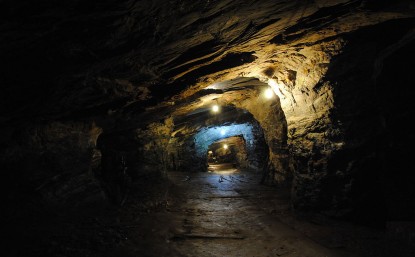
Australian-listed Orinoco Gold (Ticker: ASX:OGR) (OGR:ASX) is endowed with expansive central Brazilian gold and silver assets, most notably the Company’s 70% owned Cascavel Gold Project, within the Faina Greenstone Belt. Orinoco could have one of the cheapest risk-adjusted valuations of any gold company on the planet. Of course, many emerging gold producers presumably make stake to the same claim. What if I told you that Orinoco Gold has one of the strongest natural resource sector management teams and Board of any company with a market cap under US$ 50 million (my opinion only, I’ve spoken with several of them). A Company that’s expected to be commence production in 5 – 6 months, a fully permitted & fully funded high-grade gold project with all-in sustainable costs estimated at roughly US$ 700/oz. CY 2016 gold production of ~20,000 ounces, (~14,000 ounces net to Orinoco) and a major prospective silver deposit beneath the gold.
Orinoco is also making robust progress at its nearby 100% owned Sertão Gold Project. Orinoco intends to largely self-fund the Sertão Project and may never need to access the equity markets again, (my opinion only) except for capital for accretive, tuck-in acquisitions. Orinoco acquired the Sertão minning leases, including the past producing Sertão Gold Mine, from Troy Resources in February, 2014. The leases are located 28 km by road from Orinoco’s high-grade Cascavel Gold Project. The Sertão Gold prospect is located on an existing mining lease, and boasts historical production of 256,000 ounces of gold at a remarkable grade of 25g/t from a shallow open pit. Sertão offers meaningful potential for additional high-grade, coarse gold, discoveries.
Longer-term there’s the Tinteiro prospect, a poly-metallic discovery located in the central portion of the Faina Greenstone Belt, just 4 km south-west of Cascavel. Sample silver assays at Tinterio include:
- 17.5 m @ 1,263 g/t Ag
- 25.0 m @ 39.2g/t Ag: including 3m @ 97.2g/t Ag from 114m
- 4.4 m @ 760.3g/t Ag: including 1.05m @ 2,510g/t Ag from 157m
- 4.7m @ 58.6g/t Ag: including 0.85m @ 236g/t Ag from 162m
In October, 2014, Orinoco materially increased the size of its Cascavel Project after securing a 70% interest in the Garimpo prospect, a nearby tenement with known gold mineralization. The tenement is situated to the north of Cascavel and Tinteiro’s polymetallic prospects. Garimpo contains promising north-west extensions of both Cascavel & Tinteiro, extending the known Cascavel structure by 60% to approximately 4km of strike. I truly believe that Orinoco’s three highly promising deposits,Sertão, Tinteiro and Garimpo could be worth the Company’s current market cap of US$ 17 million.
As impressive as what Orinoco DOES HAVE is what the Company does NOT HAVE. Dozens or hundreds of millions of remaining cap-ex, to reach cash flow positive operations, severe geopolitical risks in places like central Asia or western Africa, management members drawing high salaries and working in cushy offices in London & Vancouver, (rarely if ever visiting the so-called “project” site) and high op-ex of $1,000/oz + that might have played well in 2011, but not so much today in high cost places like northern Canada and Australia. By comparison, consider a Management and Board, led by Orinoco’s 3 Co-Founders. Importantly, 9 of the 12 listed personnel on Orinoco’s website have either direct exposure to Brazil or are long-time experts in mining or BOTH. [Please visit list of Management & Board members.]
Co-Founders are:
Managing Director, Mr Papendieck, Diploma of Law from the NSW Legal Practitioners Admission Board (Dip. Law, NSW LPAB).
Chief Geologist, Dr. Marcelo De-Carvalho, (Metalogeny), PhD (Metalogeny & Geochemistry), CREA.
President Brazil Operations, Dr. Klaus Peterson, M.Sc (Mineralogy & Petrology), PhD (Mineralogy & Petrology), AusIMM, CREAM.Sc (Mineralogy & Petrology), PhD (Mineralogy & Petrology), AusIMM, CREA.
Orinoco’s management and Board separate it from dozens of companies clamoring, hoping, desperate to get bought out before hitting the liquidity wall. Boots on the ground is one of the most important factors in getting a mine over the finish line. The Company contracted a local mining team with 20 years of experience, including geologists, mining engineers and metallurgists. There are consultants, senior Management and Board members willing and able to bring Cascavel into production within 5 – 6 months. There are a number of employees living in Brazil year-round. I took comfort and was greatly impressed by both how many employees are on the ground in central Brazil AND how much credit senior management attributed to them. They are not labors, but key stakeholders in Orinoco’s success.
A company that trades nearly 500,000 shares daily, Orinoco Gold is flying under the radar because stakeholders have been entirely focused on bringing Cascavel to life. But first, it’s my job to bring Cascavel to life for those readers looking for attractive risk/reward opportunities. The Cascavel Project hosts high-grade, structurally-controlled, coarse gold shoots, where underground sampling returned bonanza grades including 15 meters grading 88g/t. Bulk samples of (350 meters north) and (90 meters south), respectively with recorded grades of 27g/t gold (2.8 tonnes) and 39g/t gold (500kgs) respectively.
What might investors and prospective investors be missing? One thing that is that the Cascavel project contains a non JORC-compliant resource, but that’s not as uncommon as it seems. With coarse, high-grade vein systems, drilling A LOT of holes could still fail to give evaluators comfort enough to establish a JORC-compliant resource. Even bulk sampling is not necessarily accepted for a JORC-compliant resource. So the question for Orinoco was, should it try to become JORC-compliant company spending a lot more time and money? Or, should it focus capital on moving into small-scale production? In this case, an estimated 20,000 ounces of gold in 2016, (14,000 ounces net to Orinoco). The Company made the decision to go for it. No matter what I or anyone on the Board or Management team says, some will stay away from a non JORC compliant resource. This is a blessing and a curse. While fat cat hedge fund types might wait for clear signs of value, smaller investors can dive in and possibly make considerable profits before the, “smart” money piles in.
Most readers may not recognize that the bulk of Orinoco’s mine development expenses are in the Brazilian Reals, a currency that has cratered vs. the $US dollar. As a result, in Brazilian dollars, the gold price is near an all-time high. I know this might be difficult to understand at first blush, but I did the math. That’s why with 14,000 ounces of gold (net to Orinoco) next year, the Company could generate approximately US$ 5 million in cash flow (not revenue, not gross profit, true cash flow, before cap-ex). That’s impressive for a company with a US$ market cap of US$ 17 million. Note, this assumes a US$ price of gold of 1,100. Gold prices above US$ 1,100 could generate substantial leverage to the underlying price of gold. An increase in the US$ gold price from US$ 1,100 to US$ 1,200 would be a 9% gain for physical holders of gold, but a 33% gain for Orinoco investors.
But wait, there’s more. Orinoco plans to double production to 40,000 ounces of high-grade gold in 2017 (28,000 net to Orinoco) while the percentage of leverage, 9% vs. 33% would not change, cash flow before cap-ex could double to US$10 million on a US$ 17 million market cap. Remember, that’s on an uptick in gold price by $100/oz to US$ 1,200/oz. Each $100/oz gain generates $5 million of incremental cash flow for Orinoco, all else equal.
Disclosure:
Orinoco Gold (Ticker: ASX:OGR) (OGR:ASX) is a speculative, small cap company, with limited trading volume. An investment in Orinoco Gold is not suitable for all investors. Readers and investors are encouraged to do their own due diligence before buying or selling stocks, especially small cap stocks. Due diligence should include consulting with one’s own investment advisor. The author, Peter Epstein,CFA, MBA owns shares of Orinoco Gold. Mr. Epstein is not a registered financial advisor. Readers should take this fact into careful consideration.
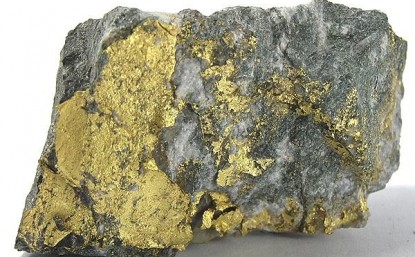
The precious metals sector has held recent lows and a rebound is underway. Gold held $1080/oz for three straight weeks and has pushed as high as $1126/oz this week. The gold miners (GDX and GDXJ) surged the first half of the week and Silver has also gained. We believe that this move is more likely to be a relief rally before Gold ultimately tests $1000/oz rather than the start of a new bull market.
Gold’s weekly candle chart is posted below and at the bottom it includes the net speculative position in Gold. Over the past two weeks Gold’s net speculative position was the lowest in 14 years! Gold pushed through $1100/oz this week after forming hammers during each of the prior three weeks. The near term upside target remains $1140-$1150/oz while near term support is $1100/oz.
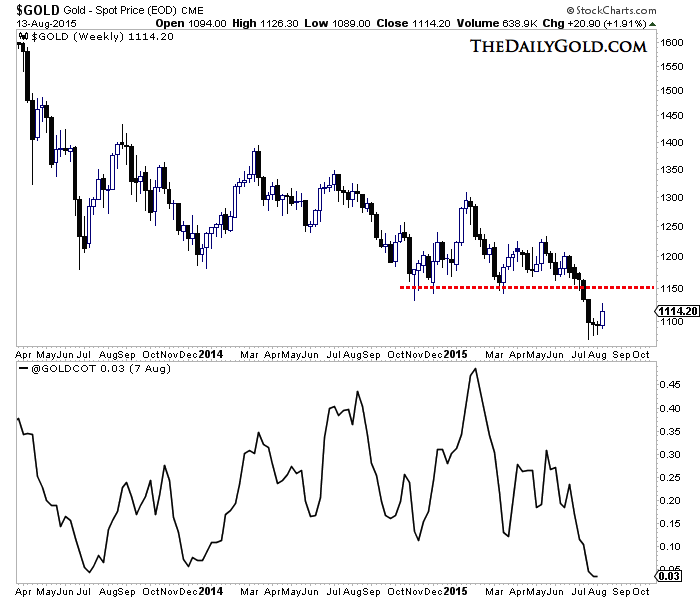
The gold miners surged at the start of the week. Through Wednesday GDX gained 14% while GDXJ gained 17%. Despite Thursday’s sharp reversal, the miners have further near term upside potential. If this rebound has legs then look for GDXJ to test $23-$24 and GDX to test $17.
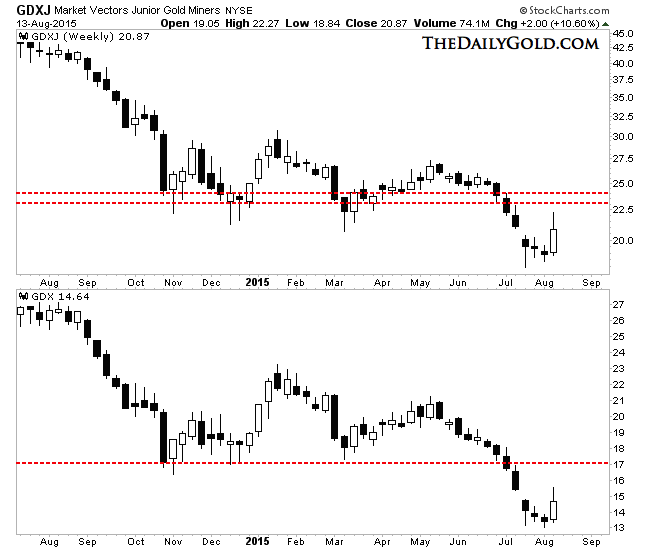
In recent weeks and months we have posted a handful of charts showing how cheap and depressed the gold miners are. We have a new one to share. Using the Barron’s Gold Mining Index (BGMI) we see that gold stocks relative to the S&P 500 (as of last week) were trading within 2% of the all-time low in 2000. This could be a major double bottom.
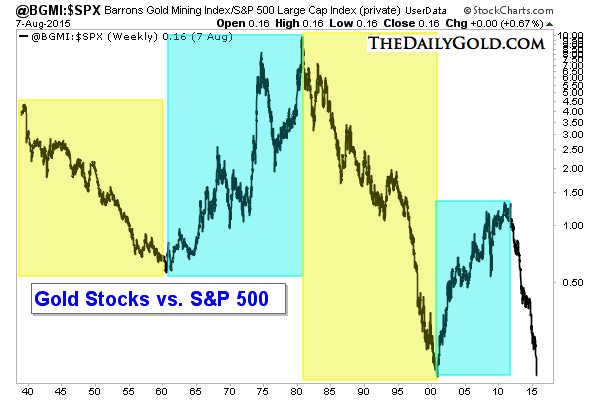
Though we believe the bear market is not quite over as we think Gold could test $1000/oz, there is an important distinction to make. As of last week the gold stocks to Gold ratio was also trading at all time lows. The gold stocks are not only extremely oversold but historically oversold. The BGMI as of last week was trading at a 13-year low and at the same level as 42 years ago! Simply put, Gold is nowhere near as oversold as the gold mining stocks. Therefore it is possible the gold stocks could bottom before Gold. Recall, this happened during the 2000-2001 lows.
That being said, we will keep all scenarios open and trade accordingly. Be aware of the risk of a Gold reversal at $1140 to $1150 and the risk of a future test $1000/oz. At the same time, consider the historic oversold condition in the gold stocks. I would not be surprised to see the juniors (GDXJ, GLDX) start outperforming Gold before Gold bottoms. As we navigate the end of this bear market, consider learning more about our premium service including our favorite junior miners which we expect to outperform in the second half of 2015.

Correlation seems almost like a magical word. In fact, most people don’t have to use this term more often than a couple of times a year. In the world of investing, however, correlation is an important concept which has to do with how different assets move in relation to one another. Before we even dive into what correlation means in the world of statistics, we’ll focus on the intuition behind it.
Investing in gold and silver, mining stocks or other precious metals usually has the goal of earning a positive return. This is usually done by taking a position in an asset. For instance, an investor buys gold in hope of the appreciation of the yellow metal. If the price of gold goes up, there is a gain. If it goes down, there is a loss. All this is very simple but the purpose of this example is to show that the price fluctuations are very important to precious metals investors and traders.
The price of gold is one of the most important figures precious metals investors look at. But gold is not the only asset in the precious metals market. Silver and mining stocks are also very important. How do they relate to one another? Do gold and silver move in the same direction? Is the relationship stable? Maybe the relationship is different for different time horizons?
There’s more. The exchange rate of the U.S. dollar is one of the most important economic indicators for the U.S.-based precious metals investors. The largest mining stocks are quoted on stock exchanges. Is there a relationship between the miners and general stock market indices such as the Standard and Poor’s 500 (S&P 500)?
Now, the relationships we’re writing about can be either positive or negative. Positive in the sense that an increase in one indicator coincides with an increase in another. For instance, an increase in the price of gold might coincide with an increase in the price of silver. It can also be negative. For instance, an increase in the exchange rate of the U.S. dollar might coincide with a decrease in the price of gold priced in the dollar.
How to measure the sort of relationships we’re writing about? Correlation provides a way to quantify this. It puts a number on the relationship. This number ranges from -1 to 1 where the most negative number (-1) corresponds to a perfectly negative relationship (when one quantity goes up, the other goes down), while the most positive number (1) corresponds to a perfectly positive relationship (when one quantity goes up, the other goes up as well).
Of course, the real world is not perfect, meaning that the correlation almost never is exactly -1 or 1. Instead, it is usually a number somewhere in between. The closer the number to -1, the stronger and more negative the relationship used to be in the past. The closer the number to 1, the stronger and positive the relationship used to be in the past. There is also a third “special” number here, namely 0, the midpoint of the range. The closer the correlation is to 0, the weaker any kind of past relationship is. When the number is close to 0, we might say that there has been no correlation between the two quantities.
How might this be of use to precious metals investors? Let’s take a look at the correlations in the first week of August 2015 to see what they might tell us. We will do this by looking at the Correlation Matrix – our tool which calculates the correlations in the precious metals market and presents them in an easy-to-digest form.
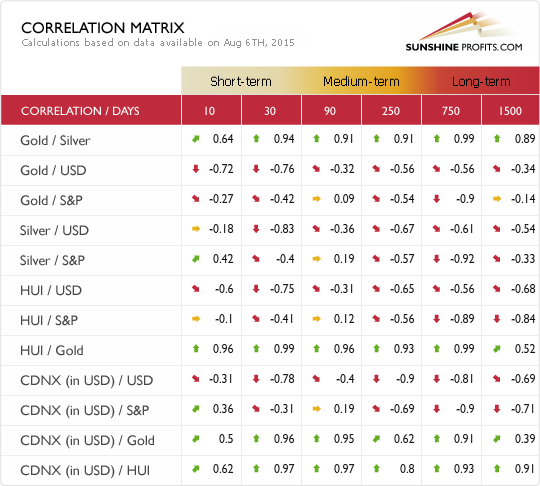
A couple of words of introduction to the tool are in order here. The column on the left-hand side shows you the pairs of assets that the correlations have been calculated for. For instance, in the first row below the header of the table, we have “Gold / Silver.” This means that this row shows the correlations calculated between gold and silver. The second row is labeled “Gold / USD.” This denotes the correlation between gold and the U.S. dollar. As such, the second row displays correlations between gold and the greenback.
Now, you have probably noticed that each row displays various correlations, not just one number. The different numbers show you the correlation over a given number of days, from 10 to 1500 (10 and 30 are marked as short-term, 90 and 250 as medium-term, 750 and 1500 as long-term). These different numbers of days are organized in columns (10, 30, 90 and so on). Putting the rows together with the columns gives you specific correlations. For example, the number in the “Gold / Silver” row, in the 1500 column is 0.89. This means that the correlation between gold and silver over the last 1500 days was 0.89. If you look at the “Gold / S&P” row and the 10 column, you see -0.27. This means that the correlation between gold and the S&P 500 index over the past 10 days stood at -0.27.
To make things easier for you, we have marked the correlations with arrows – green, red and yellow. Green arrows show you potentially strong positive correlation, red ones potentially strong negative correlation while yellow indicate that the correlation might be moderate (in either direction). The easiest way to read this is that a green arrow shows you that the two assets (indices) tended to move in the same direction, a red that the assets tended to move in opposite directions while a yellow one that the assets tended to fluctuate rather independently.
Now, let’s move to specific numbers from the table. It is commonly believed among precious metals investors that gold and silver tend to move together. With the Correlation Matrix we can verify this claim. In the “Gold / Silver” row and the 1500 column, we see 0.89 and a green arrow. This means that gold and silver in fact tended to move together over the last 1500 days (which is approximately 6 years). So, in the long term, the yellow metal tended to move together with the white metal.
The long term, however, is not all that interests us. So, let’s look at shorter time horizons. We see that the correlation between gold and silver is above 0.9 for all the horizons between 30 and 750 days. This means that in the time horizons of a month to six years (more or less) gold and silver tended to move in the same direction and strongly so. Where things get interesting is the shortest time horizon, 10 days. The correlation here is 0.64. This means that in the last 10 days gold and silver still moved in the same direction but not as strongly as in, say, the last month or the last couple of years. The implication is that the relationship in the last couple of days might have been weaker than it tended to be over the short term. This is still not very significant divergence for now but it might be in the future. Just imagine the correlation between gold and silver dropping to 0 over for the 10 day time span. This would be an important indication that the relationship between gold and silver is not as it tended to be, and so a measure worth observing.
One way to use this is to consider the short-term correlation in light of the long-term one. For instance, in the “Gold / USD” row we see the long-term correlation between gold and the U.S. dollar at -0.34 (1500 days). This means that over the long term gold and the dollar tended to move in opposite directions but definitely not perfectly so. A short glance at the short-term columns (10 days & 30 days) shows the correlations at -0.72 & -0.76. This suggests that in the recent days gold has tended to move in the opposite direction than the dollar and stronger than over longer past horizons. So, the relationship between gold and the dollar might have been stronger recently than it was on average over the last couple of years.
This might be read in two ways. Firstly, it might mean that given the more negative than usually correlation, gold might move up more in a lockstep with gold than it generally used to in the past. A move down in the dollar could be accompanied by a relatively stable move up in gold. Secondly, we might see the correlation as reverting to its long-term value. This implies that the temporarily stronger correlation between gold and the dollar might go back to weaker, less negative levels. This suggests that the short-term correlation should not be relied upon for long-term bets and it shouldn’t be the only indicator you take into account making your trading decisions.
Our last example will focus on silver and the U.S. dollar (“Silver / USD” row). It shows how you can combine the info on correlation with charts, for example to call a local bottom. The long-term correlation (1500 days) between silver and the U.S. dollar used to be negative at -0.54. The shorter-term correlation for the 30 day window is even more negative at -0.83. But the 10 day correlation is much weaker and not that negative at all (0.18). What might this mean? That silver has very recently stopped moving together with the U.S. dollar. Let’s take a look at the U.S. Dollar Index chart (charts courtesy by http://stockcharts.com).
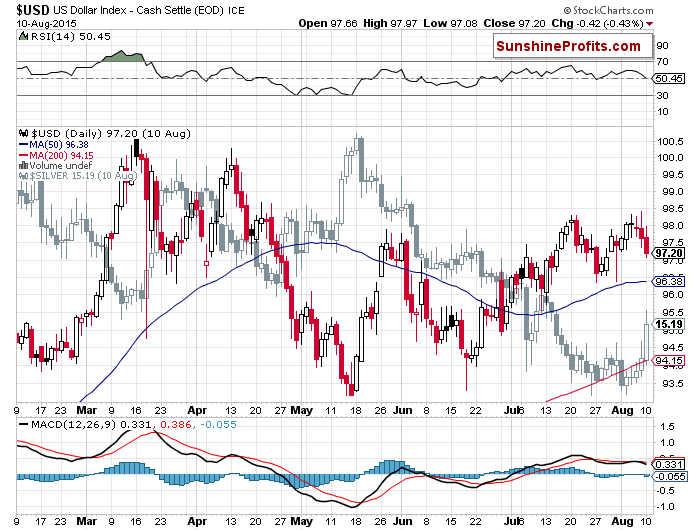
We see that up to Aug. 6, 2015, the move up in the dollar was up. At the same time, silver didn’t exactly move in the opposite direction as shown by the 0.18 short-term correlation. This might have suggested that silver was now not moving typically with respect to the dollar. In typical times a move up in the dollar might be accompanied by a move down in silver, albeit not a perfect one (long-term correlation at -0.54). The weak short-term correlation at 0.18 might have suggested that silver was trading in a different way than it usually does. In this specific case, this could mean the refusal to decline when the dollar appreciates. This, in turn, could have pointed to strength in silver and a possible move up in the future. The move up is already transpiring but it might continue even further. In this way, using the Correlation Matrix together with charts might give you additional insight into the precious metals market.

The following interview of Mr. Christopher Jones, President and CEO of Uranium Resources Inc. (Ticker: URRE) was conducted by phone and email in the week ending August 6, 2015. Uranium Resources (URRE or “URI.”) is a small cap uranium company focused on closing a proposed merger with Anatolia Energy (ASX:AEK). If the proposed merger closes (anticipated in late September), the resulting company would have a market cap of about US$ 41 million.
Importantly, all references to the merger and pro forma company are subject to the likely, but to be determined consummation of the merger. Words like, should, would, could, anticipated, possible, might, expected, and proposed (and others) are deemed to apply, as appropriate. As this is a verbal / email interview, those conditional terms may not have been used in every reference. Mr. Jones, URI’s management team and Board believe that the merger is likely to close, especially as the support of key shareholders of both companies has been obtained.
Christopher Jones joined Uranium Resources as President and CEO in April, 2013. Mr. Jones has more than 30 years of experience in positions of increasing responsibility in senior management as CEO and in operational leadership roles in the mining and energy industries. He is a member of the American Institute of Mining, Metallurgical, and Petroleum Engineers and is a Professional Engineer registered in Utah and Alberta. Mr. Jones received a Bachelor of Science in Mining Engineering at the South Dakota School of Mines and an MBA from Colorado State University. Please see applicable disclosure(s) at the end of the interview.
Please describe Uranium Resources, Inc., Anatolia Energy Limited and the proposed combined company.
On June 3, 2015, we announced a transformational merger of Uranium Resources and Anatolia Energy Ltd to create the next ISR uranium producer in the world and a leading international uranium developer with high-quality ISR and conventional uranium projects. The merger would create a dual listed (NASDAQ + ASX) company that has the lowest Enterprise Value per in-situ pound of uranium amongst its uranium peers.
URI shareholders would benefit from near-term production from Anatolia’s low-cost, high-grade Temrezli ISR Project in Turkey. Temrezli’s all-in costs of approximately $30 per pound in Anatolia’s NI 43-101 compliant Pre-Feasibility Study puts the project in the lowest cost quartile in the industry. Temrezli would allow URI to resume production sooner than would otherwise be possible. There is also considerable exploration upside in the greater Temrezli district. We would target construction and initial production as soon as possible, aligning with analysts’ estimates for a uranium price recovery.
Anatolia shareholders would benefit from URI’s vast uranium resources within projects in the major uranium districts of Texas and New Mexico and two licensed processing plants in Texas. There are substantial cap-ex synergies, lowering the estimated $41 million start-up capital for Temrezli by as much as $11 million from relocating URI’s idled Rosita processing plant to Turkey and using our internal engineering experience and expertise. Anatolia shareholders would gain improved liquidity through URI’s U.S. NASDAQ listing. The U.S is the world’s largest nuclear market, highly dependent on imported uranium. Anatolia shareholders would gain exposure to URI’s extensive inventory of uranium resources in the U.S.
The expanded URI would benefit all shareholders from a larger pipeline and large resources in some of the best uranium districts in Turkey and the U.S. We would have a geopolitically diversified and stronger platform for organic growth and corporate transactions and be more favorably positioned with customers. We appreciate the support of major shareholder Resource Capital Funds, one of the world’s largest mining-focused private equity funds. RCF owns 24% of URI. The merger is also supported by Anatolia’s major shareholders, Azarga Uranium, Sprott Asset Management and RMB Resources.
Are you able to provide readers with a pro-forma capital structure?
We expect to issue about 20.5 million shares to Anatolia shareholders, who will own 41% of the combined URI. Our existing shareholders will own 59%. On a pro-forma basis, we expect to have 51.3 million basic shares outstanding and 64.9 million fully-diluted shares post merger. URI’s stock options and 2.2 million warrants at an exercise price of $2.00 are not presently in the money.
With the proposed moving of a processing plant to Turkey, would that be a high-risk undertaking?
As announced, we expect savings totaling up to $11 million to reduce the estimated start-up cap-ex for the Temrezli Project in Turkey. Of the $11 million, we expect to save $8 million by relocating our Rosita processing plant and $3 million in Engineering, Procurement and Construction savings by using in-house expertise. A rebuild would take about the same time as new construction.
The Rosita plant design was submitted by Anatolia as part of its environmental permitting process for Temrezli. This project already has its operating license but needs to secure environmental and construction permits to begin building. Rosita is a perfect fit. It was designed and built using proven processing methods, and a design capacity of 800,000 pounds per year. The plant was designed for expansion to double capacity cost-effectively with incremental capital expenditures.
Assuming the merger closes, why sell pounds out of Turkey’s Temrezli, even if profitable, at such a low uranium price?
Good question Peter, long-term contracts would be possible and we are seeing interest. Anatolia’s CEO Paul Cronin and I met with prospective customers and investors in Hong Kong and Australia during a recent trip. Paul is having preliminary discussions with utilities for off-take agreements. Utilities are increasingly interested in evaluating long-term agreements with lower-cost projects located in stable jurisdictions.
We keep on top of what analysts and consultants like UxC project regarding the impending shortfall in uranium supply as nuclear generation expands globally in China, India and elsewhere. Many analysts anticipate a uranium deficit between 2017 and 2021, which would strengthen uranium prices in line with uranium market fundamentals.
Subject to the timely receipt of permits, Anatolia’s Pre-Feasibility Study projects full production for Temrezli in 2017. While the timing of permits could slip, Temrezli is Turkey’s first uranium mine being permitted and will be held to the same high standards seen in the U.S. and Europe.
Peter, you are correct that uranium prices in the mid $30s are quite low by historical standards. However, when we look at a long-term price of $44-$45 per pound, Turkey’s Temrezli would generate a solid margin even at these price levels. Temrezli is in the lowest cost quartile. This project has all-in sustaining costs of roughly $30 per pound, allowing it to operate profitably at very low prices. Like most emerging uranium companies, we believe that uranium prices will rebound in 2016 or 2017, coinciding with the commencement of our pipeline of projects.
What does Anatolia think of Temrezli at $55/lb uranium instead of the assumed $65/lb?
We’d enjoy a strong margin at $55/lb and higher. Looking at the sensitivity analysis in the PFS, Temrezli would have an NPV of ~US $135 million based on a $55/lb uranium price. This has the potential to be an exceptional project generating cash at virtually any uranium price.
Assuming the merger closes, when should readers expect a Feasibility Study at Temrezli incorporating the proposed relocated of the mill?
We expect to issue a JORC-compliant report early in 2016 from our ongoing technical work and are considering the appropriate report to deliver. We will be better able to discuss possible enhancements when a report is issued, rest assured the relocation of the Rosita plant remains part of the plan. Optimization also involves identifying and removing bottlenecks to enhance on-time on-budget construction and start-up.
Approximately when might Temrezli commence production? How long to ramp up to its capacity of 800k pounds per year? What about 1.6 million pounds?
Initial production is projected in late 2016 under Anatolia’s PFS. It could take up to two years to reach full production, peaking at over 1 million pounds per year. The 1.6 million pounds figure is the expansion potential of the Rosita plant. The PFS projects a 12-year mine life, providing URI time to conduct district exploration on properties like Sefaatti, quite near the Temrezli site.
Please describe the Company’s historical, non-compliant resources vs its NI 43-101 compliant resources.
We will build value for our shareholders from assets in our pipeline by advancing the development or monetizing assets to pull forward lower cost production opportunities. The merger with Anatolia does this. Our Texas and New Mexico projects, including our remaining processing plant in Texas, provide diversification and a large resource base leveraged to a rebound in the uranium price.
The Canada National Instrument 43-101 and the Australian JORC standards are recognized internationally. We are committed to JORC as the expanded URI will be listed on the Australian Stock Exchange, serving our new shareholders after the merger.
Since joining URI in 2013, our new management team has produced three independent NI 43-101 compliant reports for Roca Honda, Cebolleta and Juan Tafoya, all in New Mexico. Cebolleta is ready to advance to the next stage of a Preliminary Economic Assessment. The other reports recommended infill drilling at Cebolleta and Juan Tafoya to upgrade the resources to the Indicated category. We have an independent Feasibility report for the Churchrock Project in New Mexico that has federal permits for production of up to 3 million pounds.
URI has produced 8 million pounds of uranium in Texas. The Company shut production in 2009 as it was no longer economic. URI has reserves of 664,000 pounds contained within 419,000 short tons at an average grade of 0.08% in South Texas and non-reserve mineralized material of 118 million pounds of uranium in 39 million short tons at an average grade of 0.15% in New Mexico.
U.S. investors are cautioned that, “mineral resources” are not recognized and do not have economic support to demonstrate that the, “resource” can or ever will be converted to reserves.
Tell us more about the value of the existing URI pipeline while the uranium market has been in a slump.
In the past nine months we have done four transactions, rapidly reshaping Uranium Resources with near-term ISR production potential in Turkey and an improved mid-term production profile in the U.S. We divested our conventional underground Roca Honda Project in two strategic steps to pull forward our ISR production potential through the Butler Ranch and Alta Mesa Este projects in Texas.
Most recently, we purchased for $150,000, an historic data set for our Butler Ranch properties with a historic non-compliant resource estimate of 1.3 million pounds within 427,100 tons at an average grade of 0.15%. We also obtained geologic logs for over 2,000 exploration drill holes, maps and cross sections. That works out to about 10 cents per pound in acquisition costs.
Might Resource Capital Funds help fund the project cap-ex in Turkey?
Resource Capital Funds has stated that it will support our merger and participated with us in the due diligence review of Anatolia. RCF also indicated it will evaluate providing project finance for the Temrezli Project in Turkey which I believe speaks volumes as to the quality of that project.
Roughly what uranium price is required and how much capital and time to get into production in the U.S.?
Before the proposed plan to relocate one of our two processing plants, Rosita to Temrezli, we estimated all-in costs in the low $40s/lb to restart Rosita or Kingsville Dome. We believe these costs are at a similar level to other ISR production in Texas. We have two long-term sales contracts for 5 million pounds with no specified time delivery, which average a price just above the spot price. We need an increase in prices to provide a 10% margin for safety. It would take us about six-nine months to restart initial production in South Texas.
For my final question, are there misconceptions about Uranium Resources Inc. or Anatolia that you would like to address?
URI was founded in 1977 and has produced 8 million pounds from ISR operations in Texas. So, we really are an old name with a new story. This combination of Anatolia and URI affirms that the new story. Temrezli enjoys established infrastructure of power, roads and water. There will soon be high-speed rail service nearby. I saw Turkey’s rapid growth first hand when I was there in April.
Turkey has a forward-thinking energy policy to develop energy independence, including nuclear power generation with construction underway of the country’s first nuclear power plant.
We have transformed URI with this proposed merger to pull forward production at one of the best uranium deposits in the world.
Over the past 2.5 years, we have made great strides:
- We expect to close the pending merger with Anatolia this fall and to fast track Temrezli to production.
- Doing more for less, we reduced our cash expenditures and ongoing overhead from $17 million in 2012 to $9 million (not including the proposed merger) in 2015, even while expanding the scope of work.
- We completed Phase one drilling on Butler Ranch and Alta Mesa Este in the first half of 2015 showing an extension of the mineralized zone at Butler Ranch.
- We delivered three NI 43-101-compliant reports for the Roca Honda, Juan Tafoya and Cebolleta projects in New Mexico.
If one is looking for a growth story, and exposure to a rebound in uranium prices, I urge readers to look at Uranium Resources, Inc. (Ticker: URRE). We believe the proposed merger with Anatolia and prospective synergies would make us a meaningful mid-tier uranium company. Please review our corporate presentation for more information. Note that our presentation specifically addresses the attributes of the proposed merger. Readers are encouraged to also read more about Temrezli on Anatolia’s website.
I have no prior or existing relationship with Anatolia Energy, AEK (Australian listed). I do not own shares of AEK at this time.
Uranium Resources Inc. (Ticker: URRE) is a speculative, small cap company listed on the U.S. markets. An investment in Uranium Resources is not appropriate for everyone. Readers and investors are encouraged to do their own due diligence before buying or selling stocks, especially risky small caps. Due diligence should include consulting with your own investment advisor. The author, Peter Epstein, owns no shares of Uranium Resources. Mr. Epstein is not a registered financial advisor. Readers should take this fact into careful consideration.
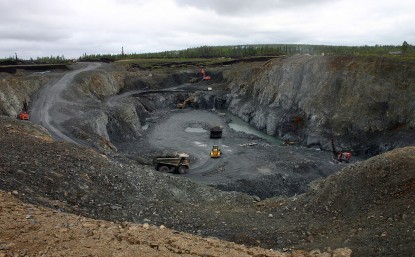
The precious metals complex has attempted to stabilize over the past few weeks. Some markets have had more success than others. Gold has been able to hold $1080/oz while GDXJ has also held its recent low. The large cap indices (GDX, XAU, HUI) have grinded lower to new bear market lows this week. This leads us to the near term predicament. Is the sector basing before a rebound or merely consolidating before another steep leg down?
Gold will certainly give us the answer and it could come within a few days. While Gold has held support at $1080/oz it has yet to break above $1100/oz. A daily close above $1100/oz would likely lead to $1140/oz whereas a daily close below $1080/oz could lead to a decline down to major support around $1000/oz. We should note that the current net speculative position in Gold is the lowest in 14 years at 3.4% of open interest or ~15K contracts. I would not be surprised to see speculators eventually become net short Gold.
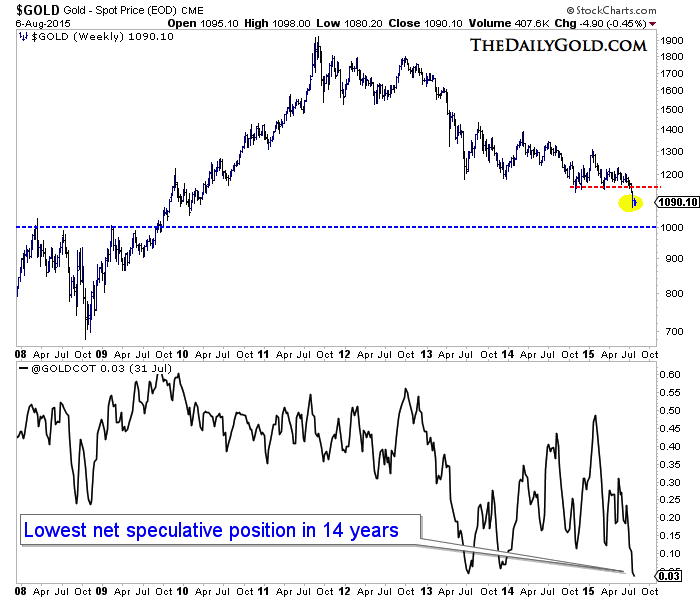
Gold is not quite as oversold as the gold miners which have been beaten and bludgeoned to death. GDXJ and GDX, charted below, show black candles in each of the past seven weeks and in GDX’s case eleven of the past twelve weeks. The miners are extremely oversold based on any and every metric and period. Note the price action over the past few weeks. The miners have failed to rally but have not closed near the lows of the week. That suggests waning selling pressure or accumulation. A rebound could begin at any moment.
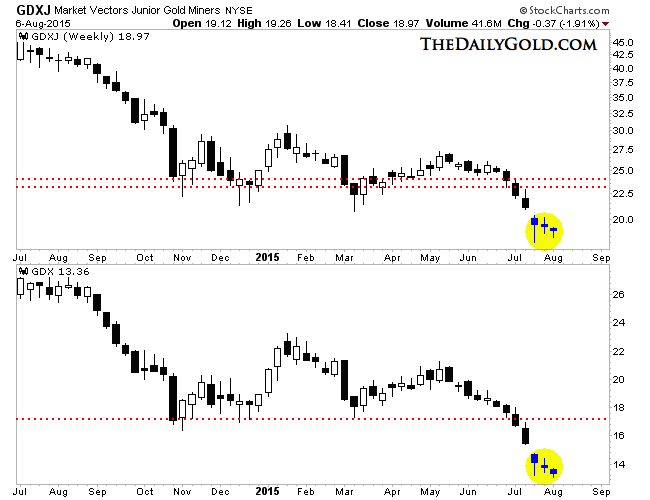
It would be quite interesting to see what happens to the miners if Gold were to break below $1080/oz and decline towards $1000/oz. Given that the miners are already extremely oversold (and in their worst bear market ever), it is quite possible they begin to rebound before Gold reaches support at $1000/oz. In addition, if this is the way Gold breaks (lower rather than higher) then it is also quite possible that the bear market ends after that decline. That would be sooner than everyone expects.
The near term remains uncertain but we could get clarity on Friday. In any case, the precious metals sector is due for a rebound. Failure to rebound in the days ahead tells us that we could ultimately see an even greater and more significant rebound from lower levels. As we navigate the end of this bear market, consider learning more about our premium service including our favorite junior miners which we expect to outperform in the second half of 2015.

1.In an inflationary environment, silver bullion and junior/intermediate gold stocks tend to outperform gold bullion and senior gold stocks.
2. Please click here now. That’s the daily gold chart. The price now is well below where it was at the November 2014 lows.
3. Next, please click here now. That’s the GDX daily chart. It’s also well below all its recent intermediate trend lows.
4. Please click here now. That’s the daily silver chart.
5. Rather than staging a technical “break down”, silver has essentially been trading sideways, and it has not traded significantly below than the November lows.
6. From the May highs, silver has drifted lower, whilst gold fell somewhat violently.
7. This difference in price action is typical when system risk fades, and inflation begins to dominate precious metals price discovery.
8. Please click here now. That’s the GDXJ daily chart. While there is a downwards bias in play, the price action really takes the form of a sideways drift.
9. Given the greater risk profiles of silver and GDXJ, (versus gold and GDX) it’s very positive to see them trading roughly sideways, while gold and most senior gold stocks tumble lower.
10. This price action suggests a concerning rise in inflation may be closer than most analysts think it is.
11. Please click here now. That’s the US dollar quarterly bars chart. The dollar has stalled at round number resistance of 100, and it’s technically overbought by a number of measures.
12. There are also a number of concerning macro issues facing America right now. The next debt ceiling vote probably takes place at the end of September. If the ceiling is raised without serious measures in place to reduce that debt, rating agencies could issue downgrades of US government debt.
13. It’s not a comfortable situation, and it’s certainly not one that I’m keen to invest in.
14. The September-October time frame is also “stock market crash season”. The worst US stock market crashes in history have occurred in the months of September and October.
15. This year is a particularly dangerous one, because a Fed rate hike could occur just as the debt ceiling is being hotly debated by US congress!
16. With these great fundamental dangers to America in place now, the idea that gold needs to be sold to avoid lower prices seems rather bizarre. Are analysts who are vehement about avoiding gold market drawdowns now… treating gold more as a gambling chip than an asset? Unfortunately, I think so.
17. Please click here now. That’s a snapshot of Saxo Bank economist Steen Jakobsen being interviewed by CNBC. Obviously he has serious concerns about the US economy, and about the dollar.
18. As the Chinese economy transitions from an exports focus to a domestic consumption focus, the need for a weak renminbi diminishes. The IMF is likely to accept the Chinese currency into its main reserve basket in October, and that acceptance will probably create significant forex flows out of the dollar, and into both Chinese stock markets and the renminbi.
19. In the longer term, Chinese real estate markets are more likely to suffer than the Chinese stock market. That’s where the biggest shadow banking loans are, and it’s likely to put a modest drag on Chinese GDP growth. It could also lead to a crash in other global real estate markets, particularly if the US debt ceiling debate gets out of hand.
20. Regardless, retail sales are showing double digit growth in China, whilst the US is in the seventh year of its business cycle, and fading.
21. That US cycle is old and reaching the point where it becomes inflationary, so it’s time to invest less in America, and more in China, India, and gold.
22. On that note, please click here now. That’s the daily chart for INDA-NYSE, the Indian stock market ETF. Like the US stock market, it’s gone essentially sideways in 2015, and it could crash if the US stock market crashes.
23. I’m more interested in what happens after a crash, and buying into that crash as it happens, than working maniacally to avoid it. In the case of America, if there’s a stock and bond market crash, I don’t really see much hope of a recovery after that, to meaningfully higher prices.
24. In contrast, in the case of China, India, and gold, all market declines should be viewed as key price sales that will be followed by much higher prices.Let me repeat: Inflation tends to rise in the late stages of the business cycle, and the outperformance of silver and GDXJ versus gold and GDX speaks volumes about where the United States is now, in its business cycle. It speaks volumes about where the Western gold community should be focusing their biggest energies. Avoiding drawdowns is a game for gamblers, and I have no interest in gambling (with anything other than gambling money). Please click here now. That’s the latest COT report, and I’ve highlighted it. This key report clearly shows small investors and funds trying to avoid drawdowns by selling gold and shorting it into this decline. It shows banks almost reaching a net long position, much akin to their actions in the late 1970s. Accumulation with prudence now, is the modus operandi, of the professional gold investor!
Stewart Thomson of Graceland Updates, Guest Contributor to MiningFeeds.com
If you would like to receive our free newsletter via email, simply enter your email address below & click subscribe.
CONNECT WITH US
Tweets
Tweet with hash tag #miningfeeds or @miningfeeds and your tweets will be displayed across this site.
MOST ACTIVE MINING STOCKS
Daily Gainers
 Lincoln Minerals Limited Lincoln Minerals Limited |
LML.AX | +125.00% |
      |
GCR.AX | +33.33% |
      |
CASA.V | +30.00% |
      |
AHN.AX | +22.22% |
      |
ADD.AX | +22.22% |
      |
AZM.V | +21.98% |
      |
NSE.V | +21.05% |
      |
DYG.V | +18.42% |
      |
AAZ.V | +18.18% |
      |
GLA.AX | +17.65% |

 Follow us on Twitter
Follow us on Twitter Become our facebook fan
Become our facebook fan








